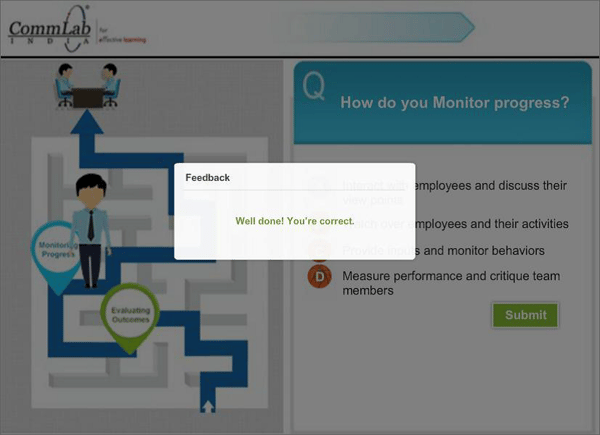Going Beyond MCQs – Gamifying Assessments to Evaluate Online Learners

Are you planning to evaluate your learners online? Do you wish to create interesting e-learning assessments? Well, go in for gamification.
What is gamification?
According to Deterding et al, gamification is the use of game design elements in non-game contexts.
Karl Kapp, a gamification guru has defined gamification as using game-based mechanics, aesthetics and game thinking to engage people, motivate action, promote learning, and solve problems.
From the above definitions, we can conclude that gamification refers to the application of game mechanics such as point scoring, competition with others, and rules of play to non-gaming activities such as learning.
What are the benefits of gamifying e-learning assessments?
Gamification helps transform bland online assessments comprising multiple-choice questions (MCQs) into interesting, stress-free learning activities and goes a long way in preventing learner monotony.
Let us now look at 5 well-designed gamified online training assessments.
5 examples of effective gamified assessments in e-learning courses
1. Find Your Way
In this game, the learner helps an animated character find his way through a maze by answering single-select multiple choice questions correctly. On the learner clicking each balloon, a question appears as shown below.

If the learner selects the correct option, the character moves a step forward as shown in the image given below.

If the option chosen by the learner is wrong, the character remains where he is.
2. Water Pipe
This game can be used in online training evaluations to present single-select questions in an engaging manner.

The pipe fills with water if the learner selects the right answer.

If the learner gets the answer wrong, the pipe remains empty.
3. Speedometer
This gamified e-learning assessment can be used for single-select as well as multi-select multiple choice questions.
Single-select questions: If the learner selects the correct option, the indicator in the speedometer moves from the minimum speed to the maximum.


In case he is wrong, the indicator will not move and continue to be at minimum speed.
Multi-select questions: If the learner selects all the correct options, the indicator moves from minimum to maximum speed. And if he is partially correct, the indicator moves to 50% speed. In case he is totally wrong, the indicator will remain at minimum speed.
4. Trivia Time
This gamified online training assessment is modeled after the popular board game Monopoly. It can be used to present single-select questions in an interesting manner.


The learner picks a game piece of his favorite color before beginning the game. He then clicks the dice at the bottom right corner to begin the game. The game piece will move on the board according to the number of pips on the dice.
If the piece stops on a ‘Draw a Card’ square, the learner has to draw a card from the right to answer a question. If he answers the question correctly, he will earn a point; otherwise, the computer earns a point. This way, the learner has to roll the dice and answer all the questions until he finishes.
5. Chinese Game
This gamified e-learning assessment is based on a Chinese game and can be used for single-select questions. In this game, eight tabs are used to hide an image. Learners are asked to “clear the tabs” to reveal the image.

When the learner clicks a tab, a question appears. If the learner selects the correct answer, the tab disappears revealing a part of the image.

If he answers all the questions correctly, the whole image is unveiled.

If the learner fails to answer a question correctly, the part of the image behind the corresponding tab will not be revealed. For example, if the learner gets the third and seventh questions wrong, parts of the image behind the corresponding tabs are not revealed.
Note: The number of tabs can vary depending on the number of questions.
The five games, listed above, were developed using Articulate Storyline, a powerful rapid e-learning development tool. Check out this interesting article to find other interesting examples of gamification created using the Articulate tool.
Hope you liked this post.





